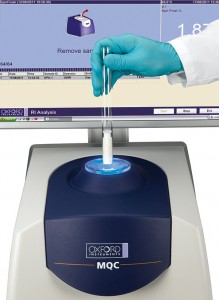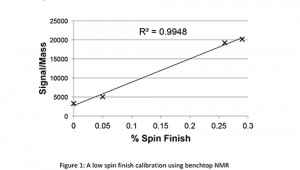
Benchtop Nuclear Magnetic Resonance (NMR) has been used for the analysis of spin finish content or Oil Pick Up (OPU) on artificial fiber for many years. The advantages over traditional extraction techniques are that it is fast, repeatable and does not use hazardous solvents. In addition, unlike most other methods/techniques, NMR measures all of the oil directly on the fiber.
Over the years the fibers and textile industries have been developing a wider array of products using a variety of polymers and coatings; and the performance of those products are optimized for a particular application. Likewise NMR methods are being developed to meet the requirements of those products. Thus NMR methods can be applied to a variety of products including, but not exclusively, yarn, monofilaments, staple fiber, textiles and nonwovens.
Flexibility
The NMR method is based on the differentiation of the hydrogen signal from different phases whether they are solid (polymer), soft solid (latex/rubber), bound (water) or mobile (oil) liquid. In some instances it is possible to measure the coating if it has been absorbed by the solid matrix. The NMR method can also selectively measure the total fluorine content usually irrespective of the matrix.
Sensitivity
A major advantage of NMR, particularly when using modern instrumentation, over traditional extraction methods is the ability to measure very low concentrations (Figure 1). This is partly due to digital electronics, which ensure clean generation and detection of the signal. In addition, magnetic resonance instruments based on rare earth magnets are smaller and lighter than traditional Alnico magnets. However performance is not compromised, therefore they have a larger sample volume (up to 14ml), higher field-strength (0.55 Tesla) and improved homogeneity – all important for accurate and repeatable measurement of low concentrations.
Figure 1: A low spin finish calibration using Benchtop NMR

Measurement of low concentrations is also critical in order to know how much spin finish has been washed off prior to other treatments. The cut-off is product dependent; however, it is typically less than 0.1%.
Repeatability
Repeatability is also a key characteristic, especially when accurately measuring low concentrations. The fact that NMR is non-destructive means that the same sample can be analyzed multiple times before being analyzed by the reference technique. In addition, the NMR method is easy-to-use with fewer steps than traditional solvent extraction methods and is therefore less prone to error.
Table 1. Measurement repeatability on a fiber sample with low spin finish content
Repeat Spin Finish (%)
1 0.268
2 0.270
3 0.268
4 0.273
5 0.271
6 0.269
7 0.272
8 0.267
9 0.276
10 0.273
Average 0.2708
Standard
Deviation 0.0027
Accuracy
There any many ways in which bench top NMR can contribute to the accurate measurement of spin finish or other oil on fiber:
1) Benchtop NMR measures a large sample, which ensures it is representative of that being produced.
2) Measurement is fast (typically one minute) so there is no limit to the number of samples that can be analyzed.
3) In contrast to traditional methods, which use solvent extraction, benchtop NMR measures all of the oil in the sample.
4) Given the above, reference values by extraction may be questionable. Therefore it is often preferable to produce calibration standards artificially by adding known amounts of oil to different fiber or textile samples.
Ease of use
Another prerequisite of modern instrumentation is its ease-of use, thus it is important for quality control analyzers to be usable by personnel with a wide range of skills. Minimal sample preparation is required; the fiber or textile is simply inserted directly into industry leading large volume tubes. Thereafter simple intuitive software provides clear instructions of each step. Calibration involves measuring reference samples with concentrations that span the range of interest to produce a linear calibration.
Safety
Replacement of wet chemical methods is always preferable when possible, not only to save money on the initial purchase and disposal of reagents, but also to remove hazards from the workplace. The absence of hot (and cold) solvents also means that the instrument does not require regular maintenance or thorough cleaning to ensure accurate results; the sample does not come in contact with the NMR instrument. In addition, polymer tubes may be used to avoid glass breakage and potential sharp hazards.
Benchtop NMR uses non-ionizing radio frequency radiation and the fringe magnetic field in the periphery of the magnet is very low and therefore safe to the majority of users, i.e., those without pacemakers.
Conclusions
Benchtop NMR is not only safe, but allows for fast, repeatable and accurate measurement of a variety of parameters, including:
- Oil-based coatings
- Fluorinated coatings
- Elastomeric coatings, e.g., rubber
- Fiber crystallinity
- Finish removal
For more information or to view a product video, visit: www.oxford-instruments.com/spin-finish

